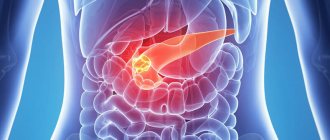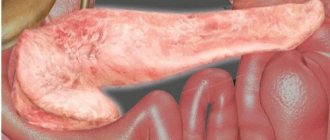Gangrenous cholecystitis is often a secondary process, since it is considered one of the most dangerous complications of another form of inflammation of the gallbladder - calculous. In gastroenterology, a similar pathology is also known as gangrene of the gallbladder. A characteristic sign of the disease is that with such a disease the tissues of this organ die, which, in turn, is caused by a violation of the blood circulation in it.
- Etiology
- Classification
- Symptoms
- Diagnostics
- Treatment
A wide range of predisposing factors can cause such a disorder, depending on which the disease is divided into several groups. The main risk group is elderly people. This is explained by the fact that the restoration processes of the gallbladder tissue are much slower, and the blood supply is weakened due to age.
The final diagnosis is made based on a doctor’s examination, as well as using a number of laboratory and instrumental examinations. Treatment of the disease is performed only surgically.
Etiology
There are several reasons for the formation of such a disease. Often this form of the inflammatory process develops against the background of calculous cholecystitis and subsequent phlegmonous. Thus, all three forms seem to flow into one another. It follows that such a disorder is secondary and quite rarely acts as an independent pathology. The primary form develops against the background of impaired blood flow in the cystic artery.
Very often, acute gangrenous cholecystitis is formed due to the influence of certain pathological microorganisms, which include:
- streptococcus;
- typhoid or E. coli;
- gas-forming microflora;
- other anaerobic microflora.
Pathogenic microorganisms can penetrate the walls of the gallbladder in several ways:
- with blood flow;
- with lymph;
- through the intestines.
In addition, a high probability of the occurrence of such a disease is observed in individuals with pronounced atherosclerosis of the blood vessels of the circulatory system.
Gangrenous cholecystitis
Causes of acute phlegmonous calculous cholecystitis
The formation of stones in the gall bladder provokes acute phlegmonous calculous cholecystitis
The causes of this condition can be divided into two groups: those that provoke the appearance of stones and those that promote the accumulation of pus.
There are also factors that equally influence both of these processes. In general, stones play a dominant role in the formation of phlegmonous cholecystitis.
Reasons for their formation:
- violation of diet, irregular food intake;
- anatomical abnormalities of the gallbladder (constrictions, deformations, reduced or increased size of the organ);
- changes in the composition of bile (it becomes thicker);
- disturbance of motor activity of the biliary tract;
- tumors or other processes that prevent bile from entering the duodenum.
Read: Crushing gallstones as a method of treating cholelithiasis
All these factors lead to the fact that bile cannot enter the duodenum in sufficient quantities and stagnates in the gallbladder. This leads to the formation of stones.
A stone can block the exit from the gallbladder (obstructive cholecystitis), which, if the composition of bile changes and infection occurs, will lead to phlegmon - the accumulation of pus, which threatens purulent melting of the gallbladder.
The infection enters the gallbladder from foci in the abdominal cavity, from the intestines, and can also be caused by parasites - opisthorchid and echinococcus.
Classification
In medicine, gangrenous cholecystitis is divided into several groups. The first of them is determined by the causes of gangrene of the gallbladder. Thus, the disease is divided into:
- primary – diagnosed most rarely and associated with impaired blood flow in the cystic artery;
- secondary – is the most common form of this disease, since it is a complication of phlegmonous and calculous cholecystitis.
Like other types of inflammation of the gallbladder, the gangrenous form exists in several forms:
- acute – characterized by a clear expression of symptoms and a gradual increase in its intensity. If treatment is not timely, it can lead to serious consequences;
- erased - observed in old age and differs from the previous course by a slight pain syndrome and a slight increase in temperature. However, more pronounced signs of dysfunction of other internal organs are observed.
Symptoms of the disease
Gangrenous cholecystitis rarely goes unnoticed, as it is accompanied by very painful symptoms.
These signs include:
- a rapid increase in human body temperature, most often this occurs at night. But at the same time, the patient may feel great and not even notice changes,
- progressive pain not only in the area where the gallbladder is located, but also in the thigh, above the inflamed organ, in the joints, in the shoulders, in the lumbar and collarbone area,
- turning on the right side, the patient feels an increase in pain,
- a disorder of the digestive system, namely a change in stool. There may be either constipation or diarrhea or alternation of both,
- nausea accompanied by severe vomiting,
- increased heart rate without any physical activity,
- dullness and dryness of the skin,
- unbearable migraines,
- general weakness of the whole body,
- constant desire to sleep,
- causeless increase in volume in the abdominal area,
- periodic feeling of either lethargy or overexcitation.
In rare cases, the following condition occurs: severe nausea, vomiting and an increased heart rate, although the patient does not have an elevated body temperature. Such an uncharacteristic condition for the patient indicates that the walls of the organ have begun to change deeply, and this is called necrosis of the gallbladder. This is the necrosis of the cells of a given organ; it is partially or completely covered with necrotic changes.
Confirming symptoms include:
- unnatural yellowness of the skin of the face and hands,
- dryness and viscosity in the oral cavity,
- a sharp drop in blood pressure,
- dizziness, loss of consciousness.
An advanced form of gangrenous cholecystitis can develop into pancreatic necrosis. This is a very terrible disease of the abdominal organs.
The pancreas begins to digest its own walls, and this threatens the destruction of its cells, in other words, necrosis. At first, the patient feels slight pain in the area of the pancreas; after about a day, the person may experience an attack that requires immediate hospitalization with surgical intervention.
Symptoms
The disease in all cases is accompanied by a pronounced clinical picture, which leads to a serious condition of the patient.
Symptoms of gangrenous cholecystitis include:
- a sharp increase in body temperature, often at night. At the same time, the person does not complain about deterioration and poor health;
- a gradually increasing pain syndrome, which can not only be localized in the projection of this organ, i.e., on the right side of the abdomen, but also often spreads over the entire surface of the anterior abdominal wall. Patients also note the spread of pain to the area of the shoulders, lower back and collarbone. The intensity of pain increases greatly in a horizontal position lying on the right side;
- bowel dysfunction, which is expressed in alternating constipation and diarrhea;
- attacks of nausea accompanied by profuse vomiting;
- increased heart rate;
- pale skin;
- severe headaches;
- general weakness and lethargy;
- constant drowsiness;
- increase in abdominal size;
- alternating lethargy and excitement.
In some cases, there is a condition called “toxic scissors.” It implies the manifestation of signs of severe intoxication of the body and pronounced tachycardia, which are combined with a completely normal temperature. This atypical course of the disease quite often indicates profound changes in the tissues of the gallbladder, up to necrosis of the walls of this organ.
Rare symptoms of the disease include:
- dampness and yellowness of the skin;
- dryness of the oral mucosa;
- the appearance of a white coating on the tongue;
- decrease in blood pressure values;
- decrease in daily urine volume;
- semi-fainting state.
Specific manifestations
In some cases, it is difficult to immediately diagnose the gangrenous type of cholecystitis due to the presence of various symptoms. People experience lethargy and confusion. Since these are often elderly people with hypertension or heart pathologies, such symptoms are associated with cerebral circulation disorders and diagnostics are carried out in this direction.
Visually observed:
- yellowness of the sclera and skin;
- dry tongue.
When palpated, the abdomen is soft, but slightly swollen, sharply painful in the projection of the liver. Tension of the abdominal wall is noted. The gallbladder and liver are enlarged. Body temperature rises (37.5-38*), there is a decrease in blood pressure, increased heart rate, and decreased intestinal motility. A specific sign of the disease is “toxic scissors.” This symptom indicates severe intoxication, accompanied by severe tachycardia. At the same time, the general body temperature is completely normal. Such specific symptoms are a sign of total necrosis of the gallbladder.
Symptoms of acute inflammation of the gallbladder
Important! Patients find it difficult to speak, so they describe symptoms confusingly. Therefore, it is advisable that the patient be accompanied by a relative who can help with the collection of anamnesis.
Diagnostics
Only a doctor can make a final diagnosis based on laboratory and instrumental examinations. But before prescribing them, a specialist needs to conduct an objective examination:
- study the medical history and life history of the patient - to search for the causes of the disease, in particular, phlegmonous or calculous cholecystitis;
- perform a thorough survey and physical examination with mandatory palpation of the abdomen, measurement of blood pressure, pulse and temperature, as well as examination of the skin - this will provide the doctor with a complete picture of the first time of appearance, presence and intensity of symptoms.
Only after this is a laboratory examination carried out, which includes:
- general analysis and blood biochemistry;
- general urine analysis;
- coprogram.
But the most valuable is instrumental diagnostics, which involves performing:
EGD procedure
- Ultrasound of the affected organ;
- radiography;
- EGDS is an endoscopic procedure for examining the internal surface of the gastrointestinal tract;
- ECG;
- CT and MRI - in cases where other instrumental diagnostic methods cannot detect pathology;
- multifractional duodenal intubation.
The acute condition is differentiated from acute appendicitis, peptic ulcer, cholelithiasis, pleurisy and myocardial infarction.
Treatment
After confirmation of the diagnosis, emergency hospitalization of the patient and immediate operation are necessary. Any delay can cause a complication such as rupture of the gallbladder, which entails the development of peritonitis, which, in turn, can cause the death of the patient.
The basis of surgical treatment is removal of the gallbladder - cholecystectomy. This operation is performed using several methods:
- laparoscopically – excision of the affected organ is performed using special instruments through several small incisions on the abdomen;
- laparotomy - removal of the gallbladder occurs through a large incision in the anterior abdominal wall.
In addition to surgery, patients are advised to take medications to relieve symptoms, as well as follow the rules of dietary table No. 5.
There is no specific prevention of the disease - it is only necessary to promptly eliminate conditions that can lead to gangrenous cholecystitis. With timely treatment, the prognosis is favorable; with the development of peritonitis, there is a high risk of death.
Classification and forms of the disease
Chronic cholecystitis can have an undulating course, when periods of remission are replaced by stages of exacerbations. Depending on their frequency of manifestations, the patient can be diagnosed with mild, moderate or severe forms.
The disease is also classified into several types:
- stoneless, or non-calculous, when stones do not form in the organ;
- calculous, with the formation of hard stones in the organ.
Diseases can occur in 3 forms:
- sluggish;
- recurrent;
- purulent ulcerative.
Non-calculous cholecystitis
The disease appears as a result of infectious lesions. Stagnation of bile occurs in the organ and a change in its composition is observed.
Infection also causes inflammation in the ducts and in the walls of the organ, resulting in their gradual destruction. The tone of the organ is disrupted, and if not treated in a timely manner, this can lead to pancreatitis and reactive hepatitis.
Calculous cholecystitis
This type of illness is more common. It is characterized by the absence of hard stones, but over time, due to stagnation of bile, they will appear in any case if the disease is not treated in a timely manner. The disease is also characterized by the presence of inflammatory processes.
A change in the ratio of lipids, bile acids, and pigments will lead to the accumulation of cholesterol, which over time will begin to precipitate in the bladder, forming hard stones in the organ. The main reason for the development of the disease is the regular consumption of fatty foods and high-calorie dishes.
The disease can also be triggered by the following factors:
- infectious diseases;
- high blood glucose levels;
- obesity;
- avitaminosis.
Calculous cholecystitis is divided into several types. He can be:
- typical;
- atypical;
- intestinal;
- esophagic;
- cardialgic.
If you do not visit a doctor in a timely manner, the disease can lead to serious complications. The patency of the ducts may be impaired, a chronic abscess or cholangitis will appear, there is a risk of hepatitis, cirrhosis of the liver, and gall bladder cancer.
The development of the disease is divided into 4 stages. At the first stage, increased thickening of bile and the appearance of microliths are observed. At the second stage, stones form; at the third, the disease takes on a chronic form. Stage 4 is characterized by various complications.
Watch a video about calculous chronic cholecystitis:











